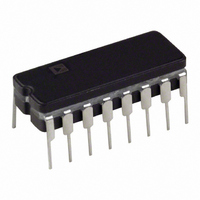AD694AQ Analog Devices Inc, AD694AQ Datasheet - Page 4

AD694AQ
Manufacturer Part Number
AD694AQ
Description
IC SGNL COND 4-20MA TX 16-CDIP
Manufacturer
Analog Devices Inc
Type
Current Transmitterr
Datasheet
1.AD694JNZ.pdf
(16 pages)
Specifications of AD694AQ
Rohs Status
RoHS non-compliant
Input Type
Voltage
Output Type
Voltage
Current - Supply
23mA
Mounting Type
Through Hole
Package / Case
16-CDIP (0.300", 7.62mm)
No. Of Amplifiers
1
Input Offset Voltage
500µV
Bandwidth
300kHz
Amplifier Output
Single Ended
Cmrr
90dB
Supply Voltage Range
4.5V To 36V
Supply Current
1.5mA
Amplifier Case Style
DIP
Rohs Compliant
No
Interface
-
Available stocks
Company
Part Number
Manufacturer
Quantity
Price
AD694
Typical Minimum Supply Voltage vs. Temperature for 2 V
and 10 V Full Scale
Voltage Reference Power Supply Rejection
I
OUT
: Voltage Compliance vs. Temperature
Maximum R
L
vs. Supply Voltage
–4–
FUNCTIONAL DESCRIPTION
The operation of the AD694 can best be understood by dividing
the circuit into three functional parts (see Figure 1). First, a
single supply input amplifier buffers the high level, single-ended
input signal. The buffer amplifier drives the second section, a
voltage to current (V/I) converter, that makes a 0 to 16 mA sig-
nal dependent current.
The third section, a voltage reference and offset generator, is re-
sponsible for providing the 4 mA offset current signal.
BUFFER AMPLIFIER
The buffer amplifier is a single supply amplifier that may be
used as a unity gain buffer, an output amplifier for a current
output DAC, or as a gain block to amplify low level signals. The
amplifier’s PNP input stage has a common-mode range that ex-
tends from a few hundred mV below ground to within 2.5 V of
V
The output range extends from about 1 mV above common to
within 2.5 V of V
The amplifier can source a maximum load of 5 kΩ, but can sink
only as much as its internal 10 kΩ pulldown resistor allows.
V/I CONVERTER
The ground referenced, input signal from the buffer amplifier is
converted to a 0 to 0.8 mA current by A2 and level shifted to
the positive supply. A current mirror then multiplies this signal
by a factor of 20 to make the signal current of 0 to 16 mA. This
technique allows the output stage to drive a load to within 2 V
of the positive supply (V
Pin 1 across resistors R1 and R2 by driving the Darlington tran-
sistor, Q2. The high gain Darlington transmits the resistor cur-
rent to its collector and to R3 (900 Ω). A3 forces the level
shifted signal across the 45 Ω resistor to get a current gain of 20.
The transfer function of the V/I stage is therefore:
resulting in a 0-16 mA output swing for a 0–10 V input. Tying
Pin 4 (2 V FS) to ground shorts out R2 and results in a 2 V
full-scale input for a 16 mA output span.
The output stage of the V/I converter is of a unique design that
allows the I
strate) potential of the device. The output transistor can always
drive a load to a point 36 V below the positive supply (V
S
. The Class A output of the amplifier appears at Pin 1 (FB).
OUT
Figure 1. Functional Block Diagram
I
OUT
pin to drive a load below the common (sub-
S
when the amplifier is operated as a follower.
=
20
×
S
). Amplifier A2 forces the voltage at
V
PIN1
/
(
R1
+
R2
)
S
REV. B
). An













